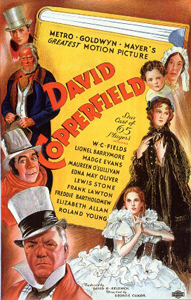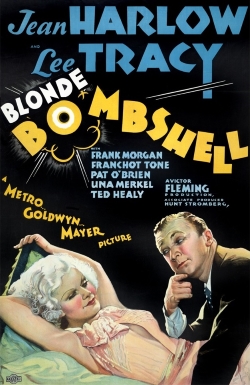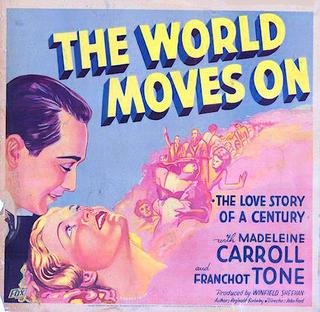
Grand Hotel is a 1932 American pre-Code drama film directed by Edmund Goulding and produced by Metro-Goldwyn-Mayer. The screenplay by William A. Drake is based on the 1930 play by Drake, who had adapted it from the 1929 novel Menschen im Hotel by Vicki Baum. To date, it is the only film to have won the Academy Award for Best Picture without being nominated in any other category.

David Copperfield is a 1935 American film released by Metro-Goldwyn-Mayer based upon Charles Dickens' 1850 novel The Personal History, Adventures, Experience, & Observation of David Copperfield the Younger.

Test Pilot is a 1938 American drama film directed by Victor Fleming, starring Clark Gable, Myrna Loy and Spencer Tracy, and featuring Lionel Barrymore. The Oscar-nominated film tells the story of a daredevil test pilot (Gable), his wife (Loy), and his best friend (Tracy).

Dr. Jekyll and Mr. Hyde is a 1931 American pre-Code horror film, directed by Rouben Mamoulian and starring Fredric March, who plays a possessed doctor who tests his new formula that can unleash people's inner demons. The film is an adaptation of The Strange Case of Dr. Jekyll and Mr. Hyde, the 1886 Robert Louis Stevenson tale of a man who takes a potion which turns him from a mild-mannered man of science into a homicidal maniac.

Stanislaus Pascal Franchot Tone was an American actor, producer, and director of stage, film and television. He was a leading man in the 1930s and early 1940s, and at the height of his career was known for his gentlemanly sophisticate roles, with supporting roles by the 1950s. His acting crossed many genres including pre-Code romantic leads to noir layered roles and World War I films. He appeared as a guest star in episodes of several golden age television series, including The Twilight Zone and The Alfred Hitchcock Hour while continuing to act and produce in the theater and movies throughout the 1960s.
The following is an overview of 1933 in film, including significant events, a list of films released, and notable births and deaths.

These Three is a 1936 American drama film directed by William Wyler and starring Miriam Hopkins, Merle Oberon, Joel McCrea, and Bonita Granville. The screenplay by Lillian Hellman is based on her 1934 play The Children's Hour.

Death Takes a Holiday is a 1934 American pre-Code romantic drama starring Fredric March, Evelyn Venable and Guy Standing. It is based on the 1924 Italian play La morte in vacanza by Alberto Casella (1891–1957), as adapted in English for Broadway in 1929 by Walter Ferris.

Bombshell is a 1933 American pre-Code romantic screwball comedy film directed by Victor Fleming and starring Jean Harlow, Lee Tracy, Frank Morgan, C. Aubrey Smith, Mary Forbes and Franchot Tone. It is based on the unproduced play of the same name by Caroline Francke and Mack Crane, and was adapted for the screen by John Lee Mahin and Jules Furthman.

Captains Courageous is a 1937 American adventure drama film starring Freddie Bartholomew, Spencer Tracy, Lionel Barrymore and Melvyn Douglas. Based on the 1897 novel of the same name by Rudyard Kipling, the film had its world premiere at the Carthay Circle Theatre in Los Angeles. Directed by Victor Fleming, it was produced by Louis D. Lighton and made by Metro-Goldwyn-Mayer. Filmed in black and white, Captains Courageous was advertised by MGM as a coming-of-age classic with exciting action sequences.

The Grapes of Wrath is a 1940 American drama film directed by John Ford. It was based on John Steinbeck's 1939 Pulitzer Prize-winning novel of the same name. The screenplay was written by Nunnally Johnson and the executive producer was Darryl F. Zanuck.

Love on the Run is a 1936 American romantic comedy film, directed by W.S. Van Dyke, produced by Joseph L. Mankiewicz, and starring Joan Crawford, Clark Gable, Franchot Tone and Reginald Owen in a story about rival newspaper correspondents assigned to cover the marriage of a socialite. The screenplay by John Lee Mahin, Manuel Seff and Gladys Hurlbut was based on a story by Alan Green and Julian Brodie. Love on the Run is the seventh of eight cinematic collaborations between Crawford and Gable. At the time of its release, Love on the Run was called "a lot of happy nonsense" by critics, but was a huge financial success, nonetheless.

Harold George Bryant Davenport was an American film and stage actor who worked in show business from the age of six until his death. After a long and prolific Broadway career, he came to Hollywood in the 1930s, where he often played grandfathers, judges, doctors, and ministers. His roles include Dr. Meade in Gone with the Wind (1939) and Grandpa in Meet Me in St. Louis (1944). Bette Davis once called Davenport "without a doubt [. . .] the greatest character actor of all time."

Three Loves Has Nancy is a 1938 American romantic comedy film directed by Richard Thorpe and starring Janet Gaynor, Robert Montgomery and Franchot Tone. It is set in New York City.

Saratoga is a 1937 American romantic comedy film starring Clark Gable and Jean Harlow and directed by Jack Conway. The screenplay was written by Anita Loos. Lionel Barrymore, Frank Morgan, Walter Pidgeon, and Una Merkel appear as featured players; Hattie McDaniel and Margaret Hamilton appear in support. It was the sixth and final film collaboration of Gable and Harlow.

The Girl from Missouri is a 1934 American romantic comedy-drama film starring Jean Harlow and Franchot Tone. The movie was written by Anita Loos and directed by Jack Conway.

Tammy and the Bachelor is a 1957 American romantic comedy film directed by Joseph Pevney and starring Debbie Reynolds as Tambrey "Tammy" Tyree, Walter Brennan as Grandpa Dinwitty and Leslie Nielsen as Peter Brent. It is the first of the four Tammy films. It was adapted from the 1948 novel Tammy Out of Time by Cid Ricketts Sumner.

The World Moves On is a 1934 American drama film directed by John Ford and starring Madeleine Carroll and Franchot Tone. It was the first Hollywood code approved film.

You Can't Take It with You is a 1938 American romantic comedy film directed by Frank Capra, and starring Jean Arthur, Lionel Barrymore, James Stewart, and Edward Arnold. Adapted by Robert Riskin from the Pulitzer Prize-winning 1936 play of the same name by George S. Kaufman and Moss Hart, the film is about a man from a family of rich snobs who becomes engaged to a woman from a good-natured but decidedly eccentric family.

Honeymoon is a 1947 American comedy film directed by William Keighley, starring Shirley Temple, Guy Madison and Franchot Tone.


















